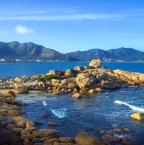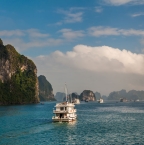
Ha Giang: The Complete Guide
Hà Giang, located in the northernmost part of Vietnam, is a hidden gem that offers breathtaking landscapes and a rich cultural heritage. Visit Ha Giang to witness its towering limestone peaks, winding mountain passes, and vibrant ethnic minority communities, all of which provide a unique travel experience.
Visitors can also explore traditional markets, visit ancient villages, and enjoy the hospitality of local people. For those seeking adventure and tranquility, a Vietnam tour that includes Hà Giang is the perfect way to immerse yourself in the untouched beauty of Vietnam's highlands.
Table of Contents
What to see in Ha Giang
Dong Van Plateau
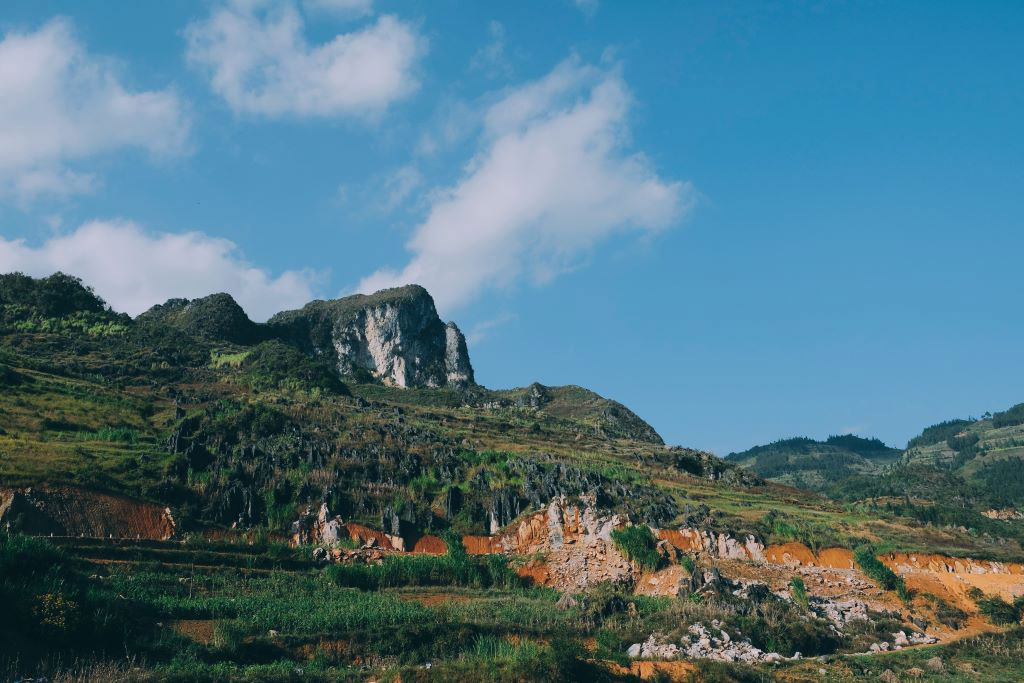
One of the four great limestone plateaus in Vietnam, about 400 km northwest of Hanoi.
The terrain is characterized by steep, narrow, passes and deep chasms, combined with fields, rice fields, fruit trees, medicinal plants, Dong Van becomes a famous land with ravishing landscapes.
Dong Van Old Quarter
An old town located in the center of Dong Van district, Ha Giang province. Well-known for its well-preserved more than 40 ancient houses built in the 1800s by the local Hmong people.
One of the most maintained old quarters in Vietnam, preserving and promoting the cultural and historical values of the H’Mong people.
Sung La Valley
A small valley located at an altitude of about 1,000 meters above sea level, with special natural scenery and beautiful scenery.
The climate is cool, fresh and lush all year round, where fruit trees such as apples, pears, plums, peaches, mangoes and root vegetables are grown. Also known for the buckwheat flower garden, which grows many different types of flowers, creating a beautiful scene, especially in autumn and winter.
Hiking to enjoy the scenery, take photos, visit the buckwheat flower garden, and experience the typical ethnic culture of the rocky mountainous region of Ha Giang.
Lung Cu flagpole
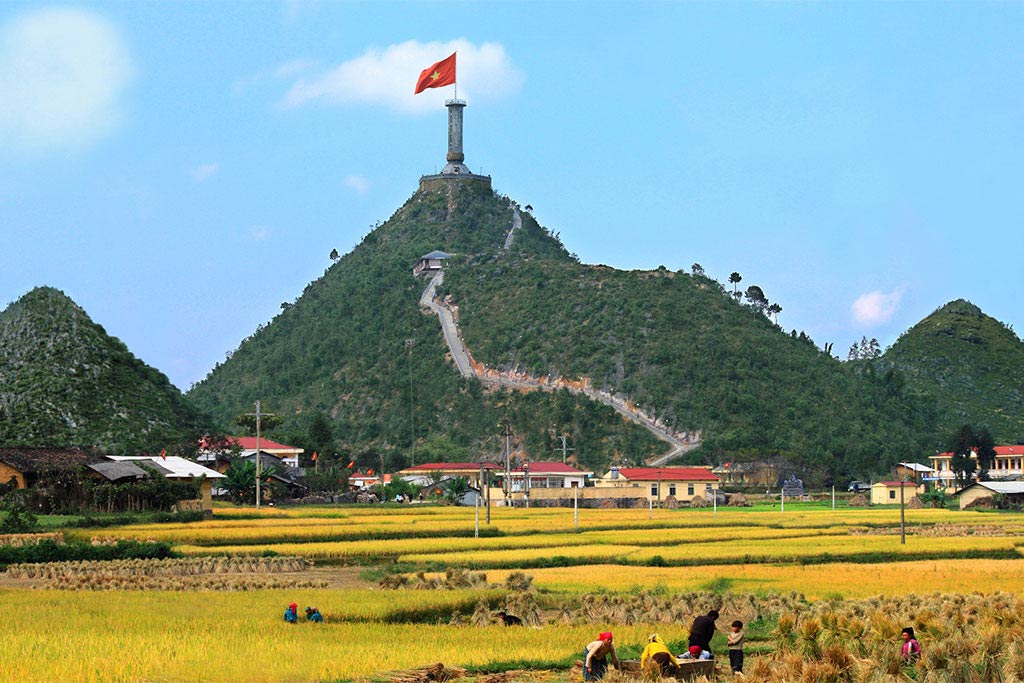
A structure located at an altitude of 1,700 meters above sea level. It is the tallest flagpole of Vietnam and is considered a symbol of the country’s sovereignty in the northern region.The height is about 33.15 meters, designed in the form of a stainless-steel flag, on the top of the column there is a 5-pointed star and a red flag with a yellow star of Vietnam.
Ma Pi Leng Pass
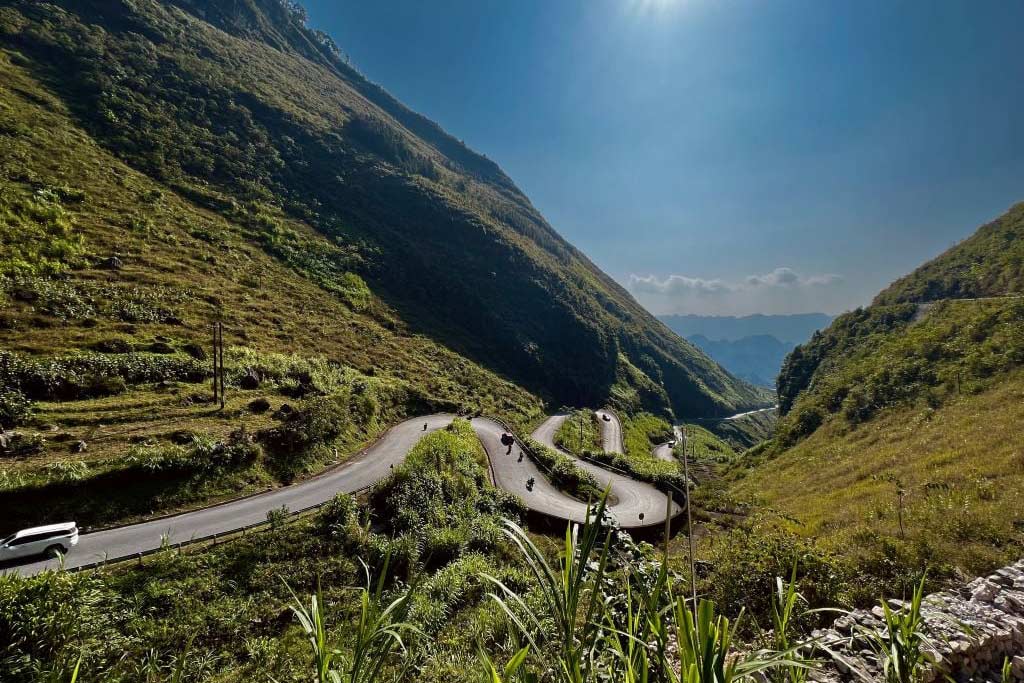
One of the most beautiful and difficult roads in Vietnam. Built in the 1960s, Ma Pi Leng nail has a length of about 20 km, an altitude of over 1,500m above sea level.
The spectacular, majestic police scene and rugged terrain have become an attractive destination for backpackers and tourists who love to explore nature. It is also famous for its difficult roads, especially steep climbs and turns, creating difficult challenges for drivers.
Lung Tam brocade weaving village
A small village located in the Dong Van district, Ha Giang province. Famous for its traditional brocade weaving techniques that have been passed down for generations.
Hoang Su Phi
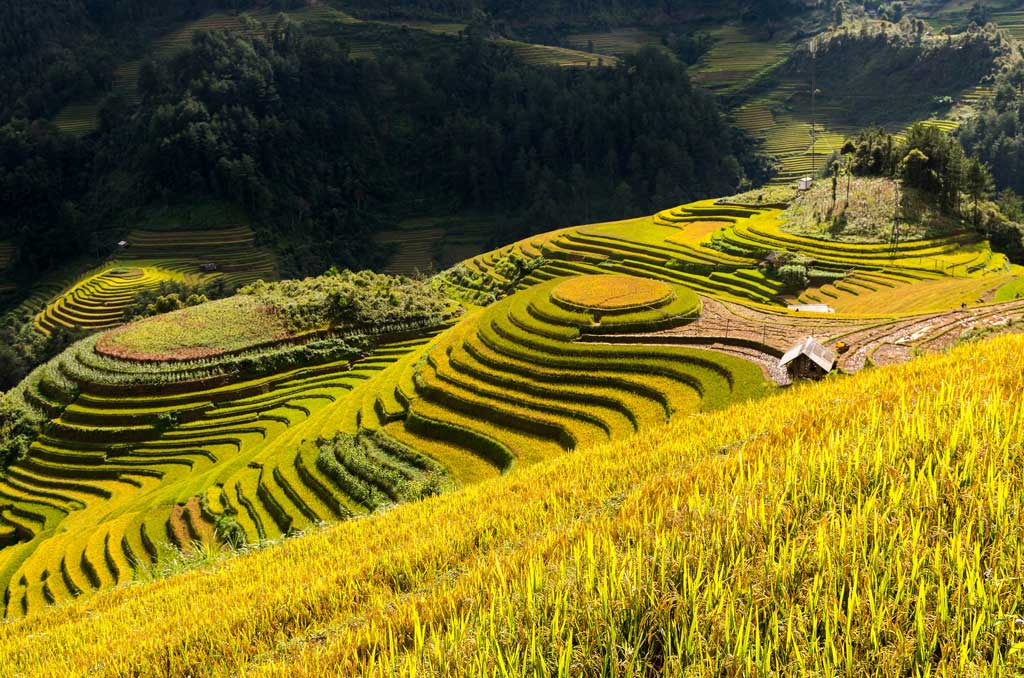
A mountainous district located in the northern province of Ha Giang, Vietnam. It is situated about 300 kilometers from Hanoi and covers an area of approximately 629.9 square kilometers. Home to several ethnic groups, including the Nung, Dao, Tay, and Hmong.
Known for its stunning terraced rice fields, which have been recognized as a National Heritage site by the Vietnamese government.
The Vuong residence palace
An ancient architectural work, located in Sa Phin town. One of the unique architectural heritages of Vietnam. Built in 1919 and completed in 1928, is the residence of the Vuong family, who ruled the land of Dong Van during the 20th century.
A harmonious architectural work, with the main blue and white tones, built with bricks and wood, creates a unique cultural space of the H’Mong people.
Nho Que River
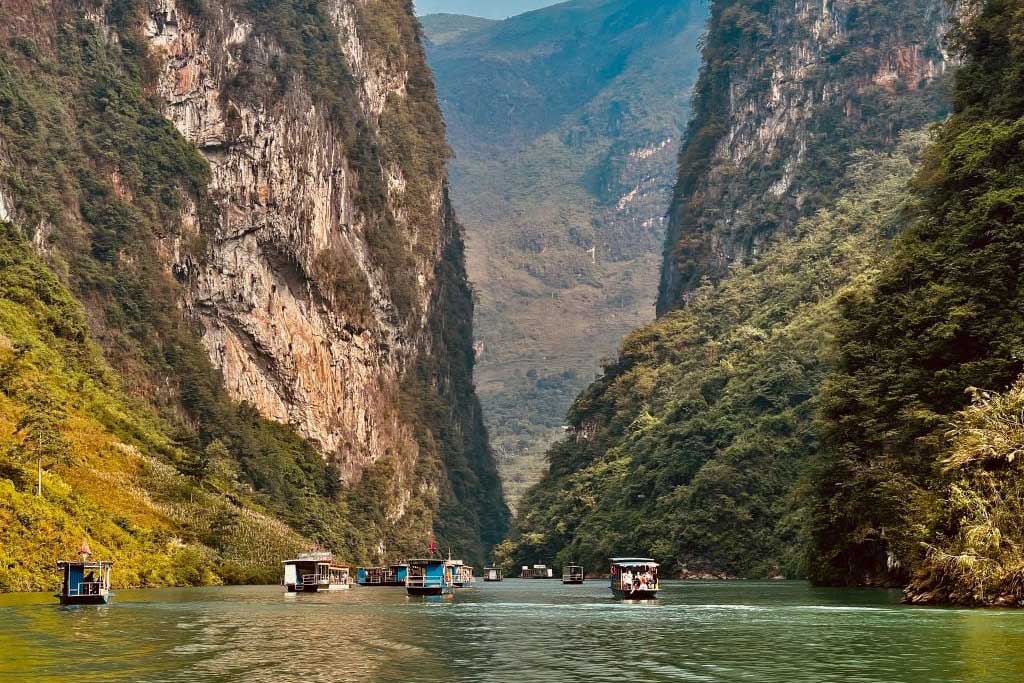
Known for its crystal-clear water and stunning scenery, including the towering Ma Pi Leng Pass. The total length of the river is about 192 km and the river basin area amounts to 2,400 km².
It is also one of the major rivers in Ha Giang, an important natural resource of the region. The river is the source of irrigation water for the rice growing, flower growing and aquaculture production areas of the riverside districts.
What to do in Ha Giang
Trekking
Ha Giang has many interesting trekking places, such as Sapa Pa, Ho Dau Dau, Chu Ma hill, Phuong Tien ancient trail, etc. You can hire a local guide for safe and enjoyable trekking.
Riding
Ha Giang has many places suitable for motorbike riding, such as Ma Pi Leng Pass, Meo Vac, Cap Van tea hill… You can rent a motorbike and explore this land by yourself.
Check-in
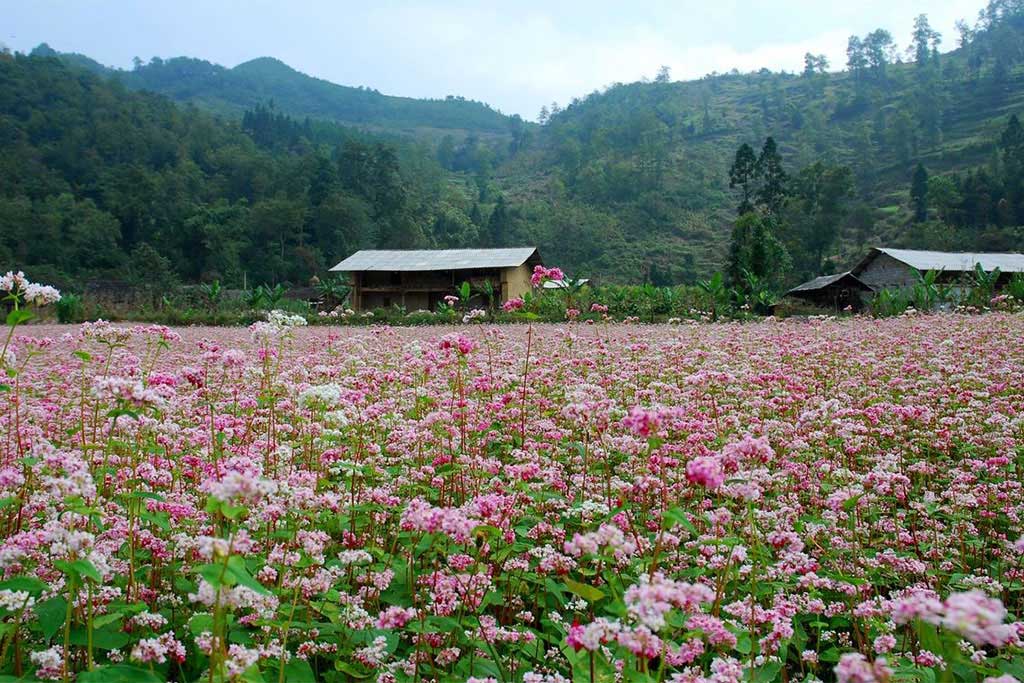
Ha Giang has many beautiful check-in places such as Tam Giac Mach, Coc Da Mountain, Cap Vat tea hill, Ma Pi Leng pass, etc. You can easily find beautiful and unique places to take pictures.
Visiting buckwheat flower field in Quan Ba
Quan Ba – Ha Giang region is one of the places with the most beautiful buckwheat flowers in Vietnam. The buckwheat flower fields in Quan Ba are attractive tourist destinations and you can easily find tours to explore this land.
Enjoy fair
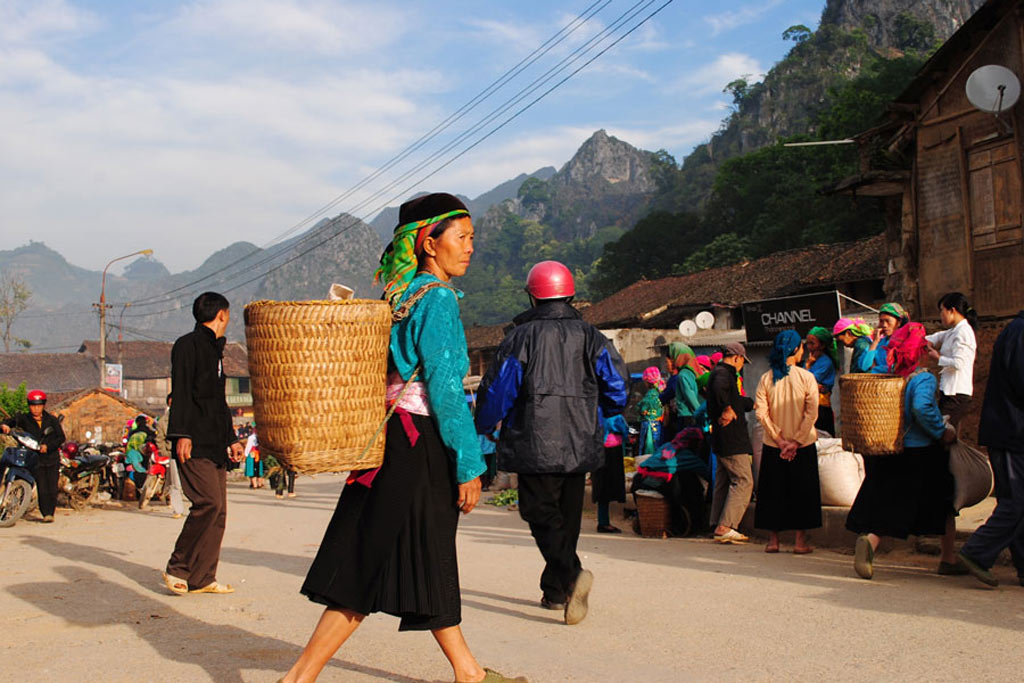
Ha Giang has many markets taking place on weekdays, such as Sung Lao market, Meo Vac market, Lung Tao market, etc. At these markets, you can enjoy local dishes and shop for products. handicrafts of indigenous peoples.
Experiment with local cuisine
Ha Giang has many typical dishes of this land, such as kitchen buffalo meat, rice lam, “thang co”, Cha Pa, “banh cuon”, etc. You can try these dishes at restaurants, local eateries to experience the unique taste of the northern land.
When to go to Ha Giang
Ha Giang, nestled in the highlands, boasts a distinctly cooler climate compared to the lowland and midland regions around it.
With an average annual temperature of 21-23°C, Hà Giang offers a unique experience throughout the year. The most enchanting times to visit are during the autumn months of October, November, and December, when golden rice fields and vibrant buckwheat flowers paint the landscape in breathtaking colors. In spring, the forests are adorned with the delicate white blooms of plum and peach flowers, creating a dreamy, cloud-like atmosphere.
In May, the terraced rice paddies sparkle with water, while June and July, despite their sudden summer rains, transform the region into a lush, green paradise. Although the rains might deter some, they enrich the scenery, making it even more mesmerizing.
How many days to visit Ha Giang
If you have 1 day in Ha Giang
- Enjoy a delicious and energetic breakfast in Quan Ba town.
- Take a motorbike or car to Ma Pi Leng pass to admire the majestic beauty of the limestone mountains and Nho Que river. You can stop at points like Ma Pi Leng cafe, Ma Pi Leng scenic spot, or Lung Tam village to take pictures and enjoy the scenery.
- Return to Quan Ba and have lunch here. You can enjoy specialty dishes such as grilled meat, lam rice, or sour bamboo shoot soup.
- Go to Nho Que valley and visit Lung Cu village, Sa Phin village, Sung Trai village to learn about the culture and life of local people.
If you have 2 days in Ha Giang
Day 1:
- Start early and head to Quan Ba Heaven Gate for a panoramic view of the Twin Mountains.
- Visit Lung Tam linen weaving village and learn about the traditional process of making linen. Have lunch in Yen Minh town.
- In the afternoon, visit the Vuong Family’s Palace to learn about the history and culture of the Hmong people. Drive to Dong Van town and check-in at a hotel.
- Enjoy dinner at a local restaurant and explore Dong Van Old Quarter.
Day 2:
- Start early and drive to Ma Pi Leng Pass for a breathtaking view of the Nho Que River.
- Visit Lung Cu Flag Tower, the northernmost point of Vietnam, and enjoy the view from the top. Have lunch in a local restaurant.
- In the afternoon, drive back to Ha Giang city and visit the market to experience the local life and buy souvenirs.
- Enjoy dinner in a local restaurant.
Where to stay in Ha Giang
Bong Bang Homestay
This is one of the prettiest homestays in Ha Giang with a very cozy layout and common yard. There are private rooms with double beds and shared rooms that are clean, lovely and fully equipped.
Auberge de MeoVac
It is a homestay with bold H’Mong characters. This is a 100-year-old H’Mong house that has been restored to serve tourists. Although the space is still traditional, the interior of the homestay is still extremely comfortable.
Lo Lo Homestay
This is a homestay in the style of a stilt house of the ethnic people, because it is located on a high slope, so from the Lo Lo balcony, you can freely watch the clouds, the mountains, and the vast fields below. There is a small note that Lo Lo only has dorm rooms.











-(1).jpg)
